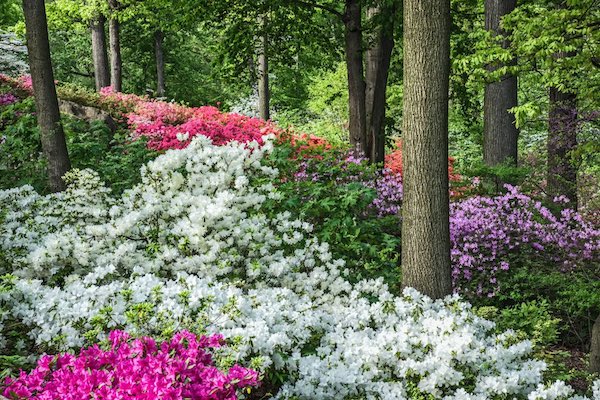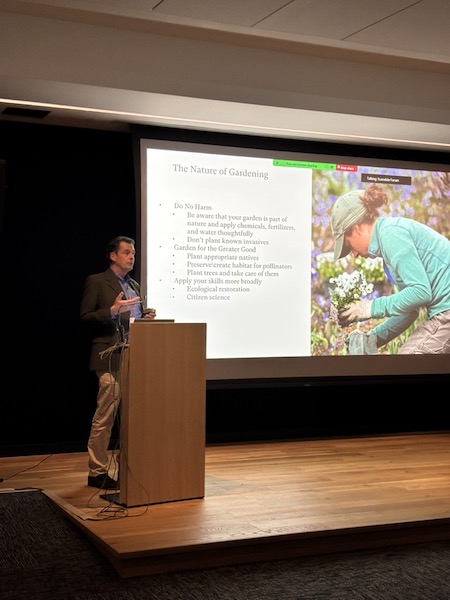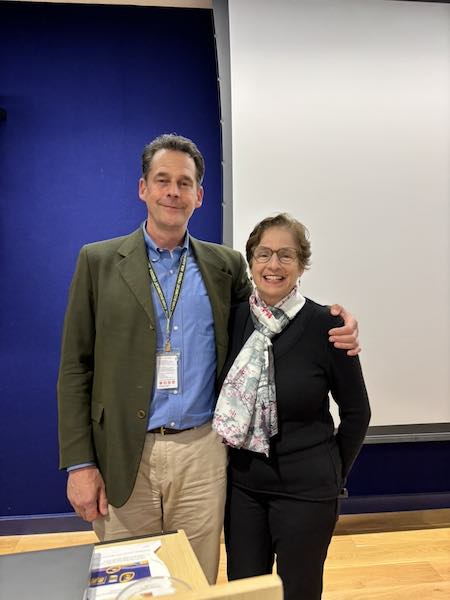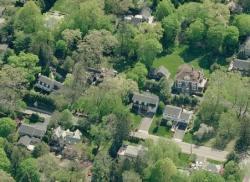Forrest Brings His Love of Gardens and Sustainable Practices to the Scarsdale Forum
- Wednesday, 02 April 2025 17:47
- Last Updated: Thursday, 03 April 2025 16:08
- Published: Wednesday, 02 April 2025 17:47
- Joanne Wallenstein
- Hits: 2640
 The Azalea Garden at NYBG: Photo by Larry LedermanWith the first spring flowers in bloom and your garden coming back to life, Todd Forrest, the Head Horticulturist at the New York Botanical Garden spoke to over 60 attendees at the Scarsdale Forum on Thursday night March 27, 2025.
The Azalea Garden at NYBG: Photo by Larry LedermanWith the first spring flowers in bloom and your garden coming back to life, Todd Forrest, the Head Horticulturist at the New York Botanical Garden spoke to over 60 attendees at the Scarsdale Forum on Thursday night March 27, 2025.
His hour-long talk spanned the history of the NYBG, toured some of the great gardens of the world and then reviewed sustainable garden practices to safeguard your own garden and the entire Bronx River watershed which Scarsdale shares with our neighbors to the south. Todd Forrest: Photo credit Susan Douglass
Todd Forrest: Photo credit Susan Douglass
He started with the history of the garden, which is just a short drive south from Scarsdale. Though we think of New York City as a densely developed urban environment, the work of early conservationists served to preserve large green spaces. Founded in 1891 by Nathaniel and Elizabeth Britton, the 250 acre garden makes the Bronx the greenest borough in Manhattan.
The original plan was designed around the path of the Bronx River and a large grove of hemlocks on the property. As the garden was installed, efforts were made to preserve every existing tree. As a result, Forrest called the garden “a 250 acre miracle in the center of the city.”
Why do we garden?
Forrest counted the reasons, the first, “to celebrate the beauty and diversity of plants.”
He showed slides of some gardens of renown at the NYBG, around the country and around the world. Among them are the Peggy Rockefeller Rose Garden at NYBG which he called “the most democratic garden in the country.” He showed photos of the Rose Garden along with Daffodil Hill, the Azalea Garden, the Lilac Garden and the Peony Garden, all at NYBG.
Gardens also serve as palates for personal expression and as a means to impress. Beyond New York, he discussed some of the world’s greatest gardens in Sussex England, at Lotusland in Montecito, CA to the Alhambra and Kyoto’s Ryoan-Ji.
Gardens are also planted to produce food. Forrest showed the New Roots Community Garden, a green swath surrounded by concrete in the Bronx. The garden which produces large amounts of healthy produce sustains hundreds.
Last he said gardens allow us to connect with nature and he showed a photo of the native plant garden at NYBG which has become one of the garden’s most popular features. Todd Forrest and Cynthia Roberts: Photo credit: Susan Douglass
Todd Forrest and Cynthia Roberts: Photo credit: Susan Douglass
Then Forrest turned to the real reason for his visit, which was to encourage the audience to adopt sustainable gardening practices to safeguard the Village, the Bronx River watershed and those downstream.
He explained that nitrogen and phosphorous released by garden chemicals, pesticides and fertilizers pose grave dangers to the entire ecosystem from bees, birds and butterflies to fish, wildflowers, plant life and humans.
40 million acres of turf grass across the country are fed by millions of pounds of fertilizer that are toxic to our earth.
He explained that it is the mission of NYBG to spread the word about biodiversity, conservation and enhancement and to share information about the changes they have made at the garden.
He showed examples of updated practices such as eliminating the weekly spraying of the rose garden, of planting compost to revitalize a dead lawn or letting a lawn go to clover and dandelions. Rather than spray pesticide to control bees, they use warm water and soap and have experimented with the use of compost tea, fish emulsion, kelp and molasses in place of harsh chemicals.
To those who wanted to know where to begin sustainable practices, Forrest advised:
-Do no harm.
-Plant trees, which he called “our most incredible asset.”
-Use native plants, not because you must but because they are beautiful and create a habitat for pollinators.
Last he said, “Apply your skills to ecological restoration and citizen science.”
Forrest just published a new book, "Gardening with Nature at the New York Botanical Garden," which he calls his love letter to the garden. Photographs by Larry Lederman. Check it out here.











